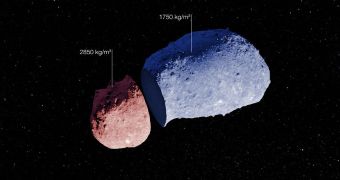Using an advanced telescope, a group of researchers from the University of Kent, in the UK, and elsewhere were recently able to determine that asteroids may have a more varied internal structure than originally assumed. The new investigation was carried out on a famous asteroid called Itokawa.
Astronomers led by professor Stephen Lowry used the European Southern Observatory's (ESO) New Technology Telescope (NTT) to study this object and were able to determine by studying a very precise set of measurements that various parts of the space rock featured different densities,
In addition to its intrinsic scientific value, this discovery is also important because it sheds more light on the processes taking place when two celestial bodies collide. Additionally, this study could potentially set the stage for a new understanding of how the solar system evolved over time.
The NTT was used to measure precisely how fast (25143) Itokawa spins around its axis. This was made easy by the fact that the asteroid is a near-Earth object (NEO). The team was also interested in learning how this spin rate changed over time. Additional data was collected from a theoretical model describing how space rocks radiate heat.
Observations of Itokawa were also conducted by the Palomar Observatory and Table Mountain Observatory, both in California, the Steward Observatory in Arizona, the Isaac Newton Telescope in Spain and the Liverpool Telescope, at La Palma, Spain.
“This is the first time we have ever been able to to determine what it is like inside an asteroid. We can see that Itokawa has a highly varied structure – this finding is a significant step forward in our understanding of rocky bodies in the Solar System,” Lowry explains.
“Finding that asteroids don’t have homogeneous interiors has far-reaching implications, particularly for models of binary asteroid formation. It could also help with work on reducing the danger of asteroid collisions with Earth, or with plans for future trips to these rocky bodies,” he goes on to say.
The recent study of Itokawa appears to suggest that the NEO asteroid formed from two distinct parts, belonging to two different asteroids which collided and merged with each other early on in the history of the solar system. Determining whether or not that is truly the case will most likely require another sample-return mission to this celestial body.

 14 DAY TRIAL //
14 DAY TRIAL //